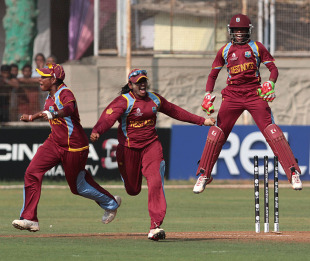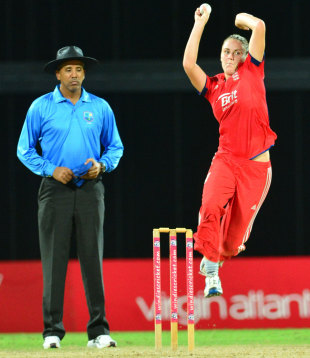| Kallis played the almost perfect innings - Petersen |
Beyond the guard of honour, the handshakes, the hashtags and the heavy hearts, there was a Test to win. The most important person knew that. Jacques Kallis, who all the above gestures were for, blocked out the occasion and batted in his bubble. The same one many thought he had left when he announced his decision to retire from Test cricket. Kallis showed them he hadn't, because there was a job to be done.
He constructed an innings that Alviro Petersen described as being the antithesis of someone on the verge of the end. "You wouldn't say he was playing in his last Test match," Petersen said. In fact, because of its cautiousness, this knock was befitting of someone at the start of his career.
At first, the wariness was out of necessity. South Africa had lost Graeme Smith and Hashim Amla within six overs of each other, Ravindra Jadeja had found turn and India's seamers were searching for reverse swing. "Even before he faced a ball, there was a wicket," Petersen remembered. He was the man out, which meant Kallis was one of two new batsmen and, like he has often had to do, needed to provide South Africa with backbone.
With that responsibility, Kallis took 16 deliveries to score his first run. In that time, AB de Villiers got off the mark and Kallis got hit on the hand by Zaheer Khan. It wasn't a body blow like the one Dale Steyn gave Ajinkya Rahane on the second day. Neither was it a delivery that exposed Kallis' reactions, like the one he bowled to Ricky Ponting in Adelaide last year, which literally floored the Australian batsman.
Ponting had said he was "embarrassed" by that ball, so much so it confirmed in his mind that his time was up. Something similar could easily have happened to Kallis, which would have vindicated and even explained the reason for his retirement. There would have been proof to back up the whispering, a result of the number of times he has been lbw playing across the line recently, that his technique was waning. Kallis seemed to be consciously guarding against that. He concentrated on solid defence, for the team and himself.
Zaheer got the ball after the blow to the hand to bounce more but Kallis was prepared. He pushed the delivery behind point for his first run. Four overs later he had added only one more, when he changed tack. He charged Jadeja and lofted over mid-off for four, twice. The Kallis who could entertain had arrived.
De Villiers, as expected, played the more adventurous innings but Kallis grew in confidence too. He had not passed 40 in seven innings before this, stretching back to February, but as he spent time in the middle he brought out the sweep and the cut.
By lunch, de Villiers had overtaken Kallis and after the break Kallis needed to resettle again. He outside edged Mohammad Shami but with no slip in place, he was safe. It was only when the afternoon wore on that Kallis brought out the drive he has built his reputation on. He treated the crowd of 6900 to a couple against Zaheer, one off the back foot and one off the front, to enter the 40s.
For the next 46 deliveries, Kinsgmead waited as Kallis retreated further. In that time, de Villiers put in a dive that might have given him a painful grass burn to avoid being run-out, and was later dismissed. After what seemed an age, Kallis punched Jadeja through point and a misfield brought him his half-century.
There was a roar of appreciation, enthusiastic applause and for a moment, Kallis allowed himself to enjoy it. He removed his helmet and whirled around to acknowledge the crowd, which included his sister, and his smile spoke of satisfaction and relief. "With all the pressure of the last Test, he stood tall," Petersen said.
After that, Kallis stood firm once more, firmer than before. With India getting a fair amount of turn with the old ball, he focused on defence, and South Africa's run rate slowed dramatically after tea. In the 15.5 overs before bad light and drizzle stopped play, they scored only 32. Although the pitch may not have facilitated a run-rate of four an over, like South Africa had on day two, such a go-slow may not have been needed for survival.
Everybody noticed Kallis' introverted approach, including Mark Boucher who thought he looked "more focused than before." With Kallis in his zone, comparisons were drawn between this innings and his maiden Test century at the MCG 16 years ago.
It speaks of the consistency of the man that he can go out in a way that is eerily similar to the manner he came in. But there is a difference between what was needed in Melbourne in 1997 and Durban today. Then, there was a Test to be saved. Now, there is a series to be won.
Some are of the opinion that Kallis slowing down could have hurt South Africa's chances of winning. Others believe he has given them the platform to push for a result. Petersen believes Kallis played "the perfect innings for the situation we were in," but that his job was not done.
"If Jacques thought he could just cruise through his last Test match, he was wrong," Petersen joked. "We are really going to need him tomorrow."
It is the last time South Africa will be able to say that and know Kallis will be able to respond. That is still sinking in. "We haven't really thought about this Test team without Jacques Kallis. But lucky, it's not quite here for us yet," Petersen said. "We've got two more days to focus on." The most important person knows that.













